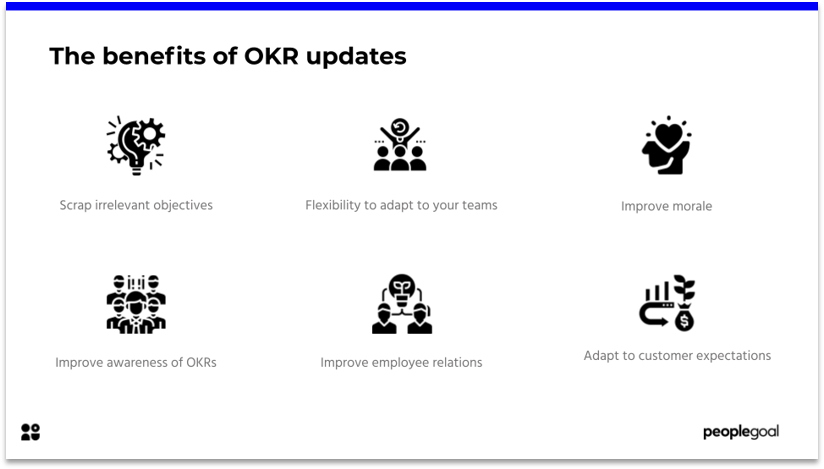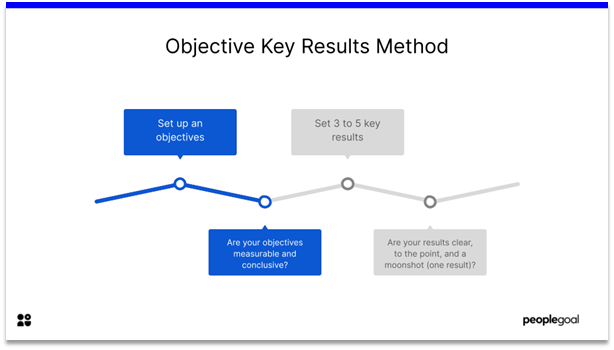The OKRs system was promoted by John Doerr, an early Google investor, back in the late 1990s. In his Ted Talk, Doerr talks about the importance of setting ‘meaningful and audacious goals’. Andy Grove taught Doerr about management by objectives – which provides an ambitious goal setting framework for organizations.
Grove said you needed to be able to look at a goal and say ‘Did I do it? Yes, no, simple’. Goals can often be vague and dreamy – ‘Improve our processes by 2022’ is one such example. Instead, OKRs provide a concrete goal framework. It’s a quantitative approach to goal-setting, so that you can objectively measure your progress to a goal.
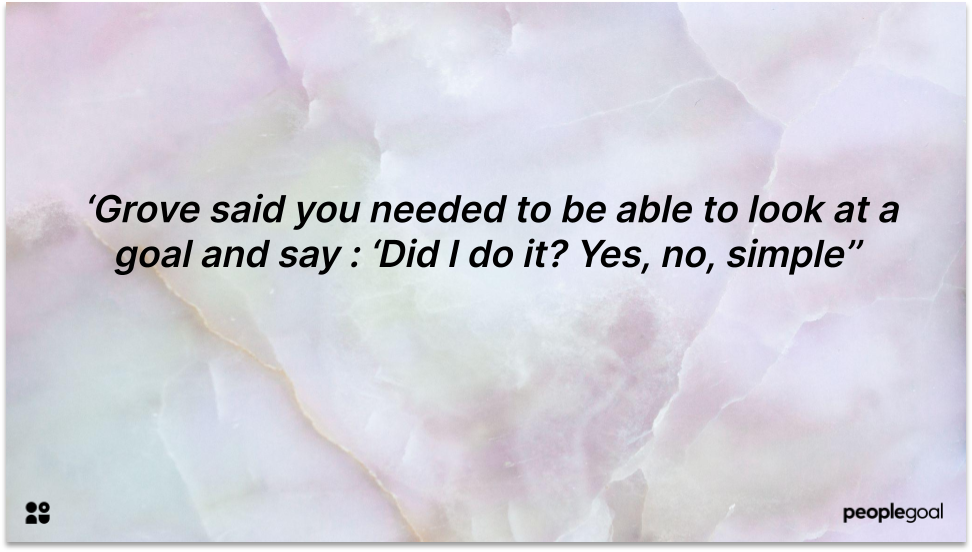
An Objective is the target you want to achieve. It’s your final destination. A Key Result is the practical bit – the measurable steps you take to achieve your objective.
OKRs are quantifiable. Google uses a scale of 0.0-1 to track progress towards Key Result. 1.0 is a completed result, and 0.6-0.7 suggests great progress. OKRs are a marathon, not a sprint. Making steady progress towards stretch goals is the aim here. That’s why a 0.6 rating is an achievement in itself.
OKRs aren’t used to make decisions about compensation. They are not performance indicators for individual employees. Instead, they aim to glue team members together with collective goals and provide a set of priorities for an organization.
Alignment is the word on everyone’s lips – and the purpose of OKRs is to connect the whole company around a shared vision. OKRs are often set democratically, with the input of all employees.
So far, so good. However, as we’ll explore below, there are plenty of downsides to this goal framework.
See John Doerr explain his thoughts on goal setting in this Ted Talk 🎥👈

How do you set OKRs?
For an explanation of how to set and track OKRs, read this post 👈
The OKR framework is simpler than it sounds. Each company level will typically set around 3-5 objectives. You can set company-wide, team and employee objectives for the best results.
Make your objectives finite. For example, you might set a goal to achieve ‘by the next quarter’. If your objectives are organization-wide, make sure they are relevant to everyone – create a shared vision.
Write between 3 and 5 Key Results per objective. Each result should be a building block towards your objective. Make them clear and actionable, such as ‘Achieve a Customer Satisfaction Rating of 5’.
Tips for Writing OKRs
- Be ambitious
- Make it time-bound
- Consult all company levels
- Decide whether to set OKRs quarterly or annually
Pros of OKRs 👍
1) Set ambitious goals
OKRs can look big and scary- for example, ‘boost sales by 20%’. They are intended to be ambitious but not impossible. If an OKR is only partially achieved, it’s a win – because the initial objective is so audacious.
This also provides focus for a department. Prioritization becomes easy – you know what Key Results need to be achieved in the next quarter to keep your team on track.
When we feel we are working towards something bigger than ourselves, we feel a stronger sense of purpose. This boosts employee engagement and satisfaction.
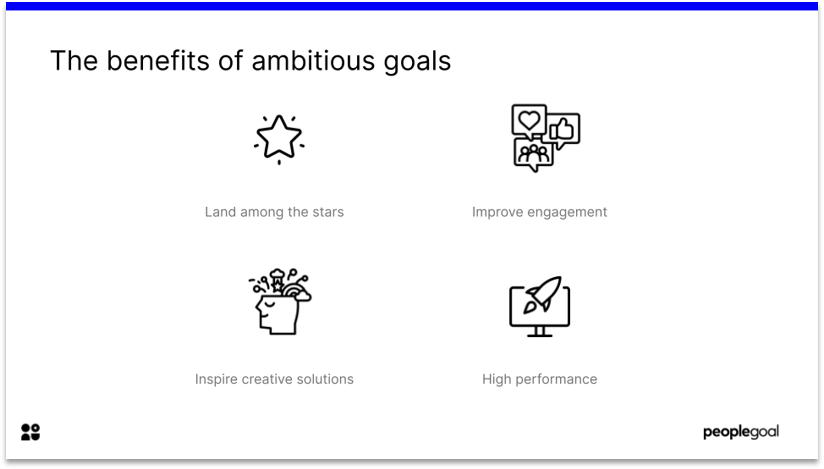
2) Reviewed regularly – usually once a quarter or monthly
OKRs inject some self-reflection into the goal-setting process. They require you to review your progress regularly.
With clear Key Results, it’s easy to quickly see where you stand. A monthly meeting with your team where you discuss progress towards OKRs gives everyone a shared purpose. Reviewing regularly can make OKRs truly motivating.
3) Quantitative
Key Results are objective: you know when they’ve been achieved. It’s easier to measure your progress when you can cross off milestones along the way.
4) Aligns everyone to a shared objective
OKRs improve goal awareness. Each team understands how their work fits into the bigger picture. OKRs are public, ensuring that everyone is on the same page.
In the remote environment, where communication between teams is often difficult, this is invaluable.
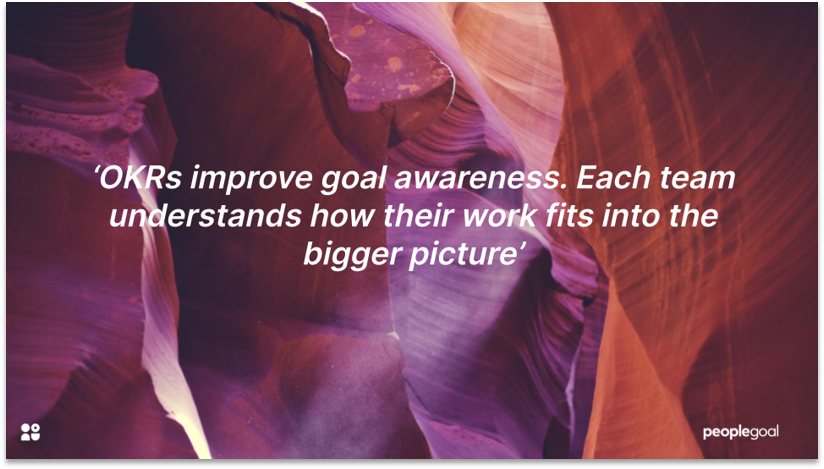
Cons of OKRs 👎
1) True alignment is a challenge
OKRs are popular among start-ups – just the organizations who deal with plenty of change. The problem is, OKRs can be too rigid for such agile environments.
As you review OKRs each month or each quarter, you might find that some are now out-dated.
As Objectives and Key Results take a while to agree on and set, it doesn’t look great to change them too often. In this sense, OKRs can hamper change-management and a team’s responsiveness to new circumstances.
2) Key results are prescriptive
Key Results are the stepping stones to your dream objective. But there are many possible routes to your goal. Your team might have out-of-the-box problem solving ideas, but if the brief is ‘Get a 4 Star rating for customer service’, they’re going to focus on that.
Experimental and innovative teams can often feel held back by Key Results. You could set OKRs more regularly, or consider making Key Results more adaptable.
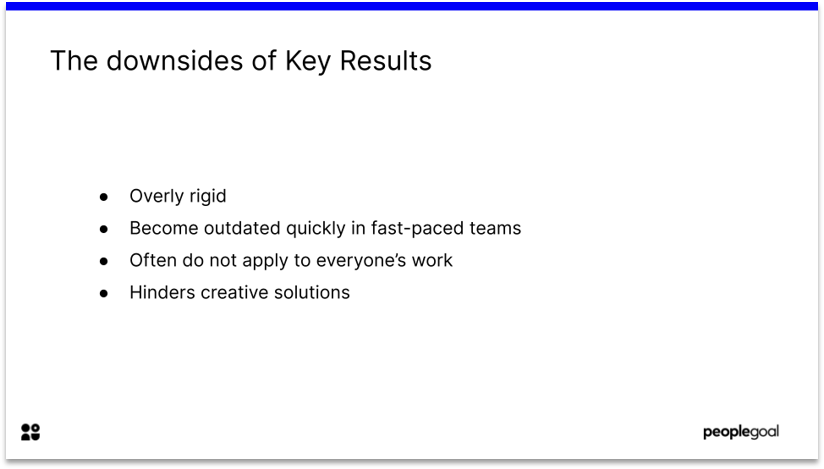
3) Organizations set too many OKRs
When you have ambitious plans, the temptation is to set more goals. But problems start to arise – OKRs don’t align with each other. Employees don’t know what to prioritise.
It’s easy to say, ‘just set fewer OKRs, then’. But different teams may have very different priorities. OKRs don’t always translate company wide. Your sales team might be revenue focused, but perhaps your product team have suggestions that compete with this – the need to invest more in product development, for instance.
Objectives and Key Results expert Christina Wodtke argues that companies should focus on just one Objective and its Key Results. This would certainly correct some alignment problems. But in a complex organization, this can look more like a vague vision than a clear target.
If your organization is overwhelmed by goal setting, rather than reaching goals, it may be time for a re-think.
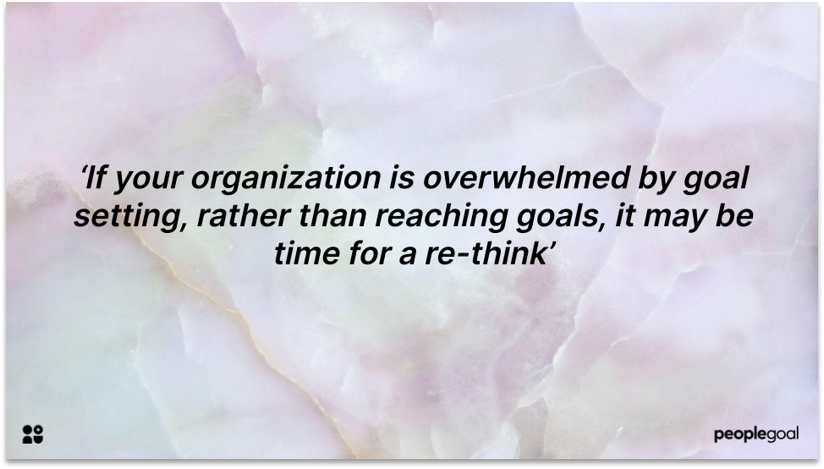
OKRs: Find what works for your team
OKRs have some downsides, but for most organizations, they are a net benefit. The alignment and transparency they offer is unmatched. If you want to connect your employees around a shared purpose, we would recommend this system.
PeopleGoal supports growing teams as they set goals. To find out more, take a look at our Performance page.
Ready to 3x Your Teams' Performance?
Use the best performance management software to align goals, track progress, and boost employee engagement.


